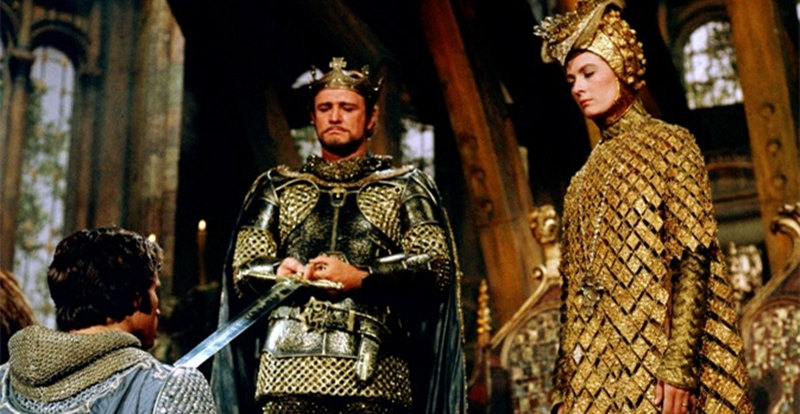Cartoonist David Low first introduced the pot-bellied, walrus-mustached Colonel Blimp to British readers in the 1930s. In single-panel installments, the military lifer held court from a Turkish bath, beginning his weekly harangue with a “Gad, Sir!” followed by an incisive analysis on the state of the world as it existed about forty years ago and exclusively in his Anglocentric imagination. The bloviating buffoon became a newspaper staple and a film adaptation seemed inevitable, but the epic that Michael Powell and Emeric Pressburger produced could not possibly have been anticipated.
In the opening sequence of “The Life and Death Of Colonel Blimp” (1943), a brash young Home Guard officer pulls off a nasty trick during a war games exercise in London and takes Colonel Clive Wynne-Candy (the ostensible Colonel Blimp, played by Roger Livesey) hostage in the Turkish baths where he is taking his leisure. The bald, semi-retired Candy (a Major General, mind you, not a Colonel) blusters at the impudent rule-breaking pup, seeming every bit the fool from the cartoon, but Powell and Pressburger have a few tricks up their collaborative sleeves. Through a lengthy flashback that returns us to 1902 and covers four decades back up to the present day, this sputtering caricature is rendered with a sensitive complexity that is rarely found in any film, let alone one loosely inspired by a comic strip character.
We are reintroduced to Clive Candy just at the end of the Boer War, when he has already made a name for himself, but has not yet grown his belly or his mustache. Candy races to Berlin when he learns about a letter written by a governess named Edith who insists the German papers are spreading vicious propaganda about the British army. He immediately proves the old axiom that soldiers that make rotten diplomats, and winds up being involved in a duel. During his Berlin days, he falls in love with Edith (Deborah Kerr) and, arguably, forms an equally close relationship with his dueling partner, Theo Kretschmar-Schuldorff (Anton Walbrook), the latter a friendship sealed by the mutual scars they inflict on each other (Candy’s upper-lip scar being the reason for his bushy ‘stache).
These two relationships and their constantly shifting configurations provide the backbone for a historical epic that omits all of the major dramatic action; Powell cuts away just as the duel begins, and the deaths of major supporting characters are announced only in newspaper clippings that are parts of decade-spanning montages. Instead, the film’s considerable screen time (163 minutes) is devoted to the prelude to and the aftermath of these turning points, quieter moments tinged with equal parts wry humor and simmering melancholy.
Candy’s love for Edith turns out to be a life-long affair even though his time with her is brief, and he spends the ensuing decades seeking replacements in otherwomen also played by Deborah Kerr; whether Candy’s obsession leads him to think these women look like Edith or the film proposes the happy notion of a world populated by Deborah Kerr clones is uncertain. Kerr was only twenty at the time, but is equally convincing as a thirty-ish governess and a plucky young driver nicknamed “Johnny.” Candy is likewise unable to let go of his friendship for Theo (in no small part because of Theo’s connection to Edith) and seeks him out during The Great War and again when Theo flees the Nazis and resides in England as an “enemy alien,” an analogue to the experience of Hungarian-born screenwriter Emeric Pressburger.
Livesey, with his distinct husky voice (his crisp, gravelly pronunciation of Kretschmar-Schuldorff is a treat in itself), is unforgettable as the ultimate stiff-upper-lip soldier. Candy always marches forward even as the burden of a lifetime of personal losses piles up on his shoulders. He meets every challenge with the wit provided by Pressburger’s deft writing; one of my favorite exchanges is when another officer says “They told me at Bloemfontein they’d cut off your leg.” Candy replies: “Can’t have, old boy. I’d have known about it!”
The film’s most moving scenes involve the aging Candy and Theo, both effectively mustered out of service for different reasons, commiserating over a lifetime of shared disappointments, but also fondly remembering shared loves. Edith’s spirit lights every dark corner in their lives just as Deborah Kerr’s crimson hair, flickering even brighter in glorious Technicolor, illuminates the screen by itself. “The Life and Death of Colonel Blimp” is one of the rarest of cinematic treasures: a historical epic that is also intensely personal and emotionally earnest.
Video:
The film is presented in its original 1.37:1 aspect ratio.
The Film Foundation completed a digital restoration of “Colonel Blimp” in 2012. The restoration demonstration feature included on the disc details the elaborate work involved in this project; restoring a Technicolor film means restoring three strips of film. The effort was certainly worthwhile as many of the old scratches and soft spots have been cleaned up and the colors are remarkably vivid. There are still a few instances when it appears a frame is missing as the film skips ahead ever so slightly, but that’s a minor inconvenience. Image resolution is sharp throughout.
Audio:
The linear PCM mono audio track sounds crisp and distortion free and all dialogue is clearly recorded. This is not a dynamic presentation, but it is more than suitable. Optional English subtitles support the English audio.
Extras:
Imported from the 2002 SD DVD release by Criterion (the Blu-ray retains the old Spine Number 173) is the selected audio commentary track by directors Michael Powell and Martin Scorsese. This was originally recorded in 1988 just two years before Powell died. I’ve heard better commentary tracks, but it is, of course, a rare pleasure to hear Powell commenting on his films. How many directors of films in the 1940s were around to record commentary tracks for the home theater releases?
Also repeated from the old SD is “A Profile of ‘The Life and Death of Colonel Blimp’” (24 min.), a 2000 documentary for Carlton International. The short documentary includes interviews with actor Stephen fry, film scholar Ian Christie, and director Kevin Macdonald, grandson of Emeric Pressburger. It’s a pretty superficial documentary, but worth taking a look at.
New for this 2012 release are an Introduction by long-time Powell and Pressburger booster Martin Scorsese (14 min.), an interview with editor Thelma Schoonmaker (29 min.) who married Powell in 1984, and a Restoration Demonstration (5 min.) also hosted by Scorsese. Both interviews are interesting, but the short restoration demo is particularly intriguing; comparisons of the old and the restored images are quite striking. It is truly amazing how much work archivists and restoration experts put into projects like this.
The disc also includes several Galleries: stills from the set, information about David Low’s comic strips, and a nice collection of the actual “Colonel Blimp” panels.
The 24-page insert booklet includes an essay by critic Molly Haskell.
Film Value:
“Colonel Blimp” was reasonably successful when it was released in 1943, but it was accompanied by controversy and strong resistance from the British War Department. Powell and Pressburger were asked not to make the film, though they were not prevented from doing so. The powers-that-be (right up to Churchill) were not comfortable with the film’s rhetoric about the potential need to adopt “dirty” tactics to fight an enemy that doesn’t play by the rules as well as a sympathetic depiction of a German soldier.
Fortunately for us (and thanks in part to the clout and support of producer Arthur Rank), “Colonel Blimp” was made and has survived intact despite multiple butchered edits for various markets. It has not generally been as widely available as some of Powell and Pressburger’s other films (“The Red Shoes,” “Black Narcissus,” etc.) but it is one of their very best. Criterion’s presentation of the newly restored film in a high-def transfer is a welcome sight, as are the additional extras for this release. This is one of the best Criterion re-releases of the year.


